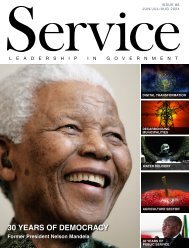Blue Chip Issue 89
Blue Chip Journal – The official publication of FPI. Blue Chip is a quarterly journal for the financial planning industry and is the official publication of the Financial Planning Institute of Southern Africa NPC (FPI), effective from the January 2020 edition. Blue Chip publishes contributions from FPI and other leading industry figures, covering all aspects of the financial planning industry.
Blue Chip Journal – The official publication of FPI. Blue Chip is a quarterly journal for the financial planning industry and is the official publication of the Financial Planning Institute of Southern Africa NPC (FPI), effective from the January 2020 edition. Blue Chip publishes contributions from FPI and other leading industry figures, covering all aspects of the financial planning industry.
You also want an ePaper? Increase the reach of your titles
YUMPU automatically turns print PDFs into web optimized ePapers that Google loves.
BLUE<br />
CHIP<br />
FINANCIAL PLANNING | Retirement<br />
Annuities: choose wisely<br />
Financial advisors have the critical challenge of helping their clients convert<br />
retirement capital into an income stream to see them through their retirement years.<br />
There are two main annuity income products (AIPs) that<br />
financial advisors assist their clients to choose from,<br />
namely: a guaranteed/life annuity (or annuitisation);<br />
and a living annuity (or self-annuitisation). The former<br />
guarantees an annuity income for life, whereas the latter<br />
exposes capital to volatile investment returns, with the possible<br />
danger of depletion before death, especially in the wake of<br />
excessive withdrawals.<br />
Contrary to the recommendation based on economic theory,<br />
very few people avail themselves of the benefits that a guaranteed<br />
annuity provides – instead most retirees prefer a living annuity, an<br />
investment portfolio from which the annuitant withdraws income,<br />
with the possibility of leaving heirs a bequest of the remaining<br />
retirement capital at death.<br />
The worldwide phenomenon of reticence among retirees to<br />
protect themselves against longevity and investment risk is an<br />
annuity puzzle that has been the subject of vigorous academic<br />
debate and applies especially in the South African context.<br />
A better understanding of the annuity puzzle is essential,<br />
especially in the wake of longer life expectancies of retirees due<br />
to medical innovation, unsustainable living annuity withdrawal<br />
rates and poor investment performance delivered by the<br />
JSE All Share Index (ALSI) from time to time.<br />
Annuity decision-making factors<br />
In my PhD research, I looked at the factors associated with annuity<br />
decision-making. Specifically, the factors (grounded in annuity<br />
puzzle literature) that relate to i) individuals’ annuity perceptions<br />
and intention pre-retirement and ii) annuitant satisfaction levels<br />
post-retirement, were investigated. The two parts of the study ran<br />
concurrently with distinctive samples. I performed a quantitative<br />
analysis on cross-sectional primary data collected by conducting<br />
survey research using online questionnaires.<br />
The sample for the first part of the study consisted of employees<br />
of Stellenbosch University (SU) who are members of the University<br />
of Stellenbosch Retirement Fund (USRF), and employees of Exxaro<br />
who are members of the Exxaro Retirement Fund.<br />
In part one of the study, 63% of the total sample (311<br />
respondents) had chosen a living annuity and 37% had chosen<br />
a guaranteed annuity. The ratio of respondents choosing a living<br />
annuity over a guaranteed annuity of ≈1.73:1 is expected, as most<br />
South Africans favour the living annuity option. The sample in<br />
part two of the study consisted of former employees of SU, who<br />
are fully retired from the USRF, and Glacier annuity clients. In<br />
part two, 76% (229 respondents) out of the total sample of 303<br />
respondents had chosen a living annuity, exactly as the<br />
annuity puzzle predicts. The data from both samples<br />
was collected in June 2020.<br />
PHOTO: ANDREA PIACQUADIO<br />
70 www.bluechipdigital.co.za


















